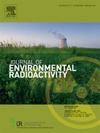Isotopic composition of 129I in marine sediments from Beppu Bay: assessing its feasibility as an Anthropocene marker
IF 2.1
3区 环境科学与生态学
Q3 ENVIRONMENTAL SCIENCES
引用次数: 0
Abstract
Anthropogenic 129I has been used as a powerful tool for tracing human nuclear activities. This study measured 127I concentrations and 129I/127I ratios in a sediment core from Beppu Bay, Japan, to evaluate the potential of 129I as a key marker for the Anthropocene. The 129I/127I ratios ranged from 1.16 × 10−11 to 1.11 × 10−10 and showed a clear increase in the 1950s, consistent with the beginning of global nuclear activities. This variation agrees with previously reported records from East Asia. Owing to the high sedimentation rate, well-preserved lamination, and redox conditions in Beppu Bay, the core retained both global increase of anthropogenic 129I and several distinct local short-term peaks of local origin. The timeline of these peaks are likely to coincides to local volcanic eruptions and extreme weather events that enhanced 129I/127I, and slightly elevated 129I/127I ratio in pre-nuclear layers suggest limited post-depositional migration under reducing conditions. Overall, the Beppu Bay core provides a high-resolution and well-dated record of 129I deposition influenced by both global and local signals. These results support the potential of 129I as a key marker in coastal marine environments for defining the Anthropocene.
别府湾海相沉积物中129I的同位素组成:作为人类世标志的可行性评估。
人为129I已被用作追踪人类核活动的有力工具。本研究测量了日本别府湾沉积物岩心中的127I浓度和129I/127I比值,以评估129I作为人类世关键标志的潜力。129I/127I比值从1.16 × 10-11到1.11 × 10-10不等,在20世纪50年代明显增加,与全球核活动的开始一致。这一变化与先前报道的东亚记录一致。由于别府湾的高沉积速率、保存完好的层压和氧化还原条件,岩心既保留了全球人为增加的129I,也保留了几个明显的局部短期本地起源峰值。这些峰值的出现时间可能与局部火山爆发和极端天气事件相吻合,这些事件增强了129I/127I,而核前层中129I/127I比值的轻微升高表明在还原条件下沉积后迁移有限。总体而言,别府湾岩心提供了受全球和局部信号影响的129I沉积的高分辨率和准确的年代记录。这些结果支持129I作为沿海海洋环境中定义人类世的关键标记物的潜力。
本文章由计算机程序翻译,如有差异,请以英文原文为准。
求助全文
约1分钟内获得全文
求助全文
来源期刊

Journal of environmental radioactivity
环境科学-环境科学
CiteScore
4.70
自引率
13.00%
发文量
209
审稿时长
73 days
期刊介绍:
The Journal of Environmental Radioactivity provides a coherent international forum for publication of original research or review papers on any aspect of the occurrence of radioactivity in natural systems.
Relevant subject areas range from applications of environmental radionuclides as mechanistic or timescale tracers of natural processes to assessments of the radioecological or radiological effects of ambient radioactivity. Papers deal with naturally occurring nuclides or with those created and released by man through nuclear weapons manufacture and testing, energy production, fuel-cycle technology, etc. Reports on radioactivity in the oceans, sediments, rivers, lakes, groundwaters, soils, atmosphere and all divisions of the biosphere are welcomed, but these should not simply be of a monitoring nature unless the data are particularly innovative.
 求助内容:
求助内容: 应助结果提醒方式:
应助结果提醒方式:


